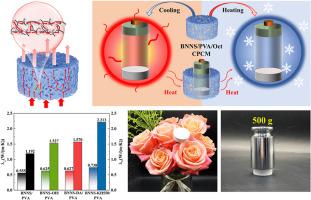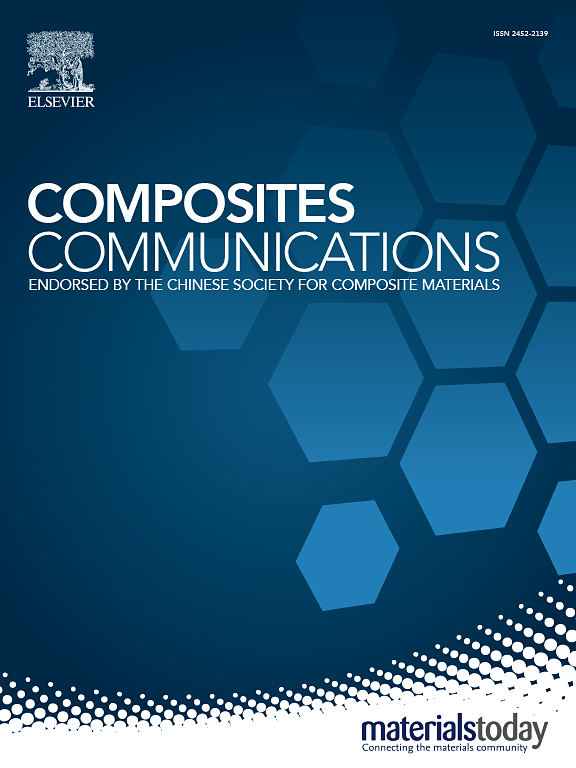增强功能化氮化硼/聚乙烯醇/十八烷复合相变材料的界面导热性,实现有效热管理
IF 6.5
2区 材料科学
Q1 MATERIALS SCIENCE, COMPOSITES
引用次数: 0
摘要
具有无泄漏相变的复合相变材料(CPCM)被广泛应用于电子设备和锂电池中,以实现高效的热管理。然而,目前的 CPCM 存在热传导率低的问题,影响了其热传导效率。本研究提出了一种新型 CPCM,它基于注入了正十八烷(Oct)的功能化氮化硼纳米片(BNNS)/聚乙烯醇(PVA)多孔骨架。通过使用 (3-aminopropyl) triethoxysilane (KH550) 作为桥接剂,增强了 BN/PVA 之间的界面相容性。实验研究和分子动力学模拟表明,与羟基(-OH)和多巴胺(DA)改性的对应物相比,KH550 改性的 BNNS 与 PVA 的界面热阻(ITR)更低。由此制得的 BNNS-KH550/PVA/Oct CPCM 的潜热值高达 171.95 J g-1,热导率高达 0.839 W m-1 K-1,抗压强度高达 3.82 MPa,并且具有优异的电绝缘性和极低的泄漏问题。CPCM 杰出的综合性能验证了其潜在的应用价值。本文章由计算机程序翻译,如有差异,请以英文原文为准。

Enhanced interfacial thermal conductivity of functionalized boron nitride/polyvinyl alcohol/octadecane composite phase-change materials towards effective thermal management
Composite phase-change materials (CPCMs) with leakage-free phase transition are widely used in electronic devices and lithium batteries for efficient thermal management. However, the current CPCMs suffer from low thermal conductivity, which hampers their heat transfer efficiency. This study proposes a novel CPCM based on a functionalized boron nitride nanosheet (BNNS)/polyvinyl alcohol (PVA) porous skeleton infused with n-octadecane (Oct). The interfacial compatibility between BN/PVA is enhanced by employing (3-aminopropyl) triethoxysilane (KH550) as a bridging agent. Experimental investigations and molecular dynamics simulations demonstrate that KH550-modified BNNS exhibits lower interfacial thermal resistance (ITR) to PVA compared to hydroxy (-OH) and dopamine (DA)-modified counterparts. The resulting BNNS-KH550/PVA/Oct CPCM exhibits exceptional latent heat value of 171.95 J g−1, high thermal conductivity of 0.839 W m−1 K−1, remarkable compressive strength of 3.82 MPa, with excellent electrical insulation and minimal leakage issues. These outstanding comprehensive performances of the CPCM validate its potential applications.
求助全文
通过发布文献求助,成功后即可免费获取论文全文。
去求助
来源期刊

Composites Communications
Materials Science-Ceramics and Composites
CiteScore
12.10
自引率
10.00%
发文量
340
审稿时长
36 days
期刊介绍:
Composites Communications (Compos. Commun.) is a peer-reviewed journal publishing short communications and letters on the latest advances in composites science and technology. With a rapid review and publication process, its goal is to disseminate new knowledge promptly within the composites community. The journal welcomes manuscripts presenting creative concepts and new findings in design, state-of-the-art approaches in processing, synthesis, characterization, and mechanics modeling. In addition to traditional fiber-/particulate-reinforced engineering composites, it encourages submissions on composites with exceptional physical, mechanical, and fracture properties, as well as those with unique functions and significant application potential. This includes biomimetic and bio-inspired composites for biomedical applications, functional nano-composites for thermal management and energy applications, and composites designed for extreme service environments.
 求助内容:
求助内容: 应助结果提醒方式:
应助结果提醒方式:


